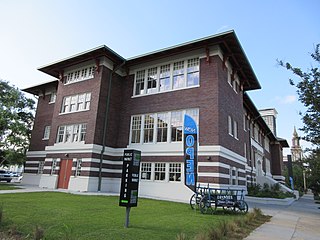
Carrollton is a historic neighborhood of Uptown New Orleans, Louisiana, USA, which includes the Carrollton Historic District, recognized by the Historic District Landmark Commission. It is the part of Uptown New Orleans farthest upriver while still being easily accessible to the French Quarter. It was historically a separate town, laid out in 1833 and incorporated on March 10, 1845. Carrollton was annexed by New Orleans in 1874, but it has long retained some elements of distinct identity.

Bywater is a neighborhood of the city of New Orleans. A subdistrict of the Bywater District Area, its boundaries as defined by the City Planning Commission are: Florida Avenue to the north, the Industrial Canal to the east, the Mississippi River to the south, and the railroad tracks along Homer Plessy Way to the west. Bywater is part of the Ninth Ward of New Orleans. It includes part or all of Bywater Historic District, which is listed on the National Register of Historic Places.

Uptown is a section of New Orleans, Louisiana, United States, on the east bank of the Mississippi River, encompassing a number of neighborhoods between the French Quarter and the Jefferson Parish line. It remains an area of mixed residential and small commercial properties, with a wealth of 19th-century architecture. It includes part or all of Uptown New Orleans Historic District, which is listed on the National Register of Historic Places.

Central City is a neighborhood of the city of New Orleans. It is located in the 11th Ward of New Orleans in Uptown, just above the Garden District, on the "lakeside" of St. Charles Avenue. A subdistrict of the Central City/Garden District Area, its boundaries as defined by the City Planning Commission are: MLK Boulevard, South Claiborne Avenue and the Pontchartrain Expressway to the north, Magazine, Thalia, Prytania and Felicity Streets and St. Charles Avenue to the south and Toledano Street, Louisiana Avenue and Washington Avenue to the west. This old predominantly African-American neighborhood has been important in the city's brass band and Mardi Gras Indian traditions.

Irish Channel is a neighborhood of the city of New Orleans. It is a subdistrict of the Central City/Garden District Area. Although the original site was located predominantly on the east side of Jackson Avenue, its boundaries as defined by the Historic District Landmarks Commission are: Magazine Street to the north, Jackson Avenue to the east, the Mississippi River to the south and Delachaise Street to the west.

Touro Infirmary is a non-profit hospital located in New Orleans, Louisiana. Founded by Judah Touro in 1852, it is a part of the LCMC Health System.

Lafayette Park is a neighborhood located east of Downtown Detroit. It contains a residential area of some 4,900 people and covers 0.37 sq mi.

Gallier House is a restored 19th-century historic house museum located on Royal Street in the French Quarter of New Orleans, Louisiana.

The Hermann–Grima House is a historic house museum in the French Quarter of New Orleans, Louisiana, United States. The meticulously restored home reflects 19th century New Orleans. It is a Federal-style mansion with courtyard garden, built in 1831. It has the only extant horse stable and 1830s open-hearth kitchen in the French Quarter.

Lower Garden District is a neighborhood of the city of New Orleans. A subdistrict of the Central City/Garden District Area, its boundaries as defined by the New Orleans City Planning Commission are: St. Charles Avenue, Felicity, Prytania, Thalia, Magazine, and Julia Streets to the north; the New Orleans Morial Convention Center, Crescent City Connection, and Mississippi River to the east; Felicity Street, Magazine Street, Constance Street, Jackson Avenue, Chippewa Street, Soraparu Street, and St. Thomas Street to the south; and 1st Street to the west.

This is a list of the National Register of Historic Places listings in St. Landry Parish, Louisiana.

William Alfred Freret Jr. was an American architect. He served from 1887 to 1888 as head of the Office of the Supervising Architect, which oversaw construction of Federal buildings.

The Louise S. McGehee School is an all-girls private, independent school in the Garden District in New Orleans, Louisiana, United States. The McGehee campus, which is one city block, has ten buildings and at least 100,000 square feet (9,300 m2) of space.

Favrot & Livaudais (1891–1933) was an architectural firm in New Orleans, Louisiana. The firm designed many buildings that are listed on the National Register of Historic Places.

James Freret (1838–1897) was an American architect who practiced in New Orleans, Louisiana, prolific in designing many homes in that area.

The neighborhood of the Faubourg Lafayette is a division in the city of New Orleans, Louisiana. It is a portion of the 10th Ward of New Orleans, and part of Central City, New Orleans. The boundaries are the lake side of St. Charles Avenue from Jackson Avenue to the Pontchartrain Expressway, back to Simon Bolivar Avenue.
The Faubourg Livaudais is a name of a neighborhood in central New Orleans that some people have re-adopted based upon the name of a former plantation that was in the area. The neighborhood is largely residential and contains mostly modest sized homes.

Soule Business College was an educational institution focused primary on practical business skills, established by George Soule in New Orleans, Louisiana in 1856, and operating until 1983.

William Fitzner, was a German-American architect who practiced in New Orleans, Louisiana, between the 1850s and his death. He was one of the most prolific designers in the city during the late nineteenth century and a major contributor to the city's expansion in the decades after the American Civil War.































